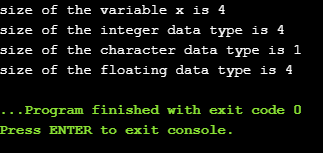📌 相关文章
- C++中的sizeof()运算符(1)
- C中的sizeof运算符
- C#中的sizeof()运算符(1)
- C中的sizeof运算符(1)
- c++中的sizeof运算符(1)
- C++中的sizeof()运算符
- C中的sizeof()运算符(1)
- C#中的sizeof()运算符
- c++代码示例中的sizeof运算符
- sizeof 运算符 - C++ 代码示例
- sizeof - C++ (1)
- sizeof运算符的结果(1)
- sizeof运算符的结果
- sizeof - C++ 代码示例
- sizeof运算符的操作数
- sizeof运算符的操作数
- sizeof运算符的操作数(1)
- sizeof运算符的操作数(1)
- java中的sizeof(1)
- java代码示例中的sizeof
- PHP sizeof()函数(1)
- PHP sizeof()函数
- python sizeof - Python (1)
- python sizeof - Python 代码示例
- C / C++中sizeof(int *)和sizeof(int)之间的区别
- C / C++中sizeof(int *)和sizeof(int)之间的区别
- C C ++中sizeof(int *)和sizeof(int)之间的区别(1)
- C C++中sizeof(int *)和sizeof(int)之间的区别(1)
- C / C ++中sizeof(int *)和sizeof(int)之间的区别
📜 C中的sizeof()运算符
📅 最后修改于: 2020-10-22 01:32:51 🧑 作者: Mango
C中的sizeof()运算符
C中通常使用sizeof()运算符。它确定表达式的大小或在char型存储单元数中指定的数据类型。 sizeof()运算符包含单个操作数,该操作数可以是表达式或数据类型转换,其中强制转换是括在括号内的数据类型。数据类型不仅可以是原始数据类型(例如整数或浮点数据类型),而且还可以是指针数据类型和复合数据类型(例如联合和结构)。
需要sizeof()运算符
主要是程序知道原始数据类型的存储大小。尽管数据类型的存储大小是恒定的,但是在不同平台上实现时,它会有所不同。例如,我们使用sizeof()运算符动态分配数组空间:
int *ptr=malloc(10*sizeof(int));
在上面的示例中,我们使用了sizeof()运算符,该运算符应用于int类型的转换。我们使用malloc()函数分配内存,并返回指向该已分配内存的指针。内存空间等于int数据类型占用的字节数并乘以10。
注意:输出可能在不同的机器上有所不同,例如在32位操作系统上将显示不同的输出,而在64位操作系统上将显示相同数据类型的不同输出。
sizeof()运算符的行为根据操作数的类型而不同。
- 操作数是一种数据类型
- 操作数是一个表达式
当操作数是数据类型时。
#include
int main()
{
int x=89; // variable declaration.
printf("size of the variable x is %d", sizeof(x)); // Displaying the size of ?x? variable.
printf("\nsize of the integer data type is %d",sizeof(int)); //Displaying the size of integer data type.
printf("\nsize of the character data type is %d",sizeof(char)); //Displaying the size of character data type.
printf("\nsize of the floating data type is %d",sizeof(float)); //Displaying the size of floating data type.
return 0;
}
在上面的代码中,我们借助sizeof()运算符来打印不同数据类型(如int,char,float)的大小。
输出量

当操作数是表达式时
#include
int main()
{
double i=78.0; //variable initialization.
float j=6.78; //variable initialization.
printf("size of (i+j) expression is : %d",sizeof(i+j)); //Displaying the size of the expression (i+j).
return 0;
}
在上面的代码中,我们分别创建了两个类型为double和float的变量’i’和’j’,然后使用sizeof(i + j)运算符print表达式的大小。
输出量
size of (i+j) expression is : 8